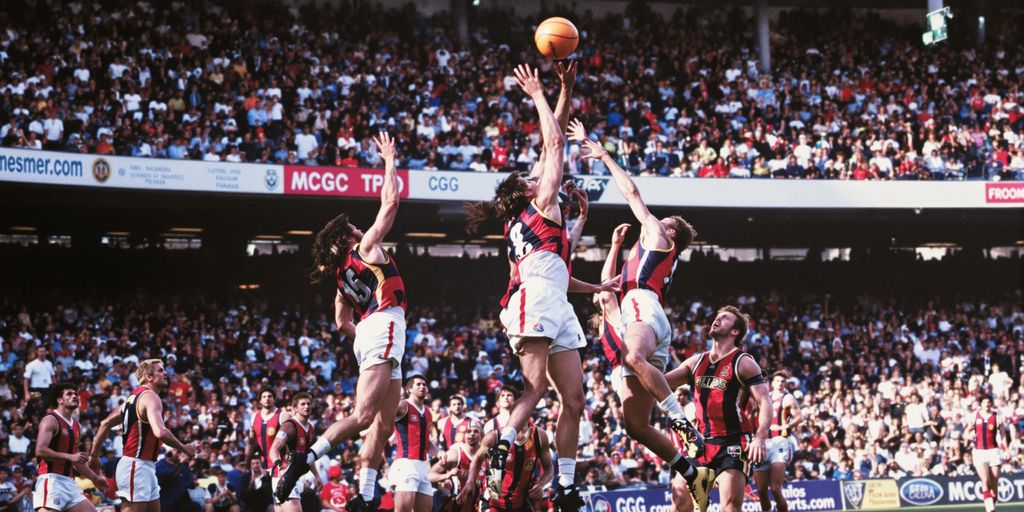The Build-Up To The 1984 AFL Grand Final
Canberra Raiders’ Journey
Canberra’s 1984 season was a rollercoaster. They finished equal fifth, a huge improvement, but heartbreakingly missed the finals after a playoff loss to South Sydney. This near-miss fuelled their determination. The media started calling them the ‘Green Machine’ after some massive wins, including a memorable one against Parramatta.
Balmain Tigers’ Road to Glory
The Balmain Tigers, on the other hand, had a different kind of season. They were hungry for a premiership, and their journey to the Grand Final was marked by consistent performance and strategic gameplay. They were a team to be feared, with a forward pack that could dominate any game. Their confidence was sky-high, and they were ready to take on anyone.
Key Players to Watch
Heading into the Grand Final, all eyes were on a few key players from both sides:
- For Canberra, Mal Meninga’s leadership and goal-kicking were vital.
- Ricky Stuart’s playmaking ability was another huge asset.
- Balmain boasted Steve ‘Blocker’ Roach, a powerhouse prop known for his aggression.
The stage was set for an epic clash. Both teams had overcome significant hurdles to reach the Grand Final, and the anticipation was palpable. The 1984 Grand Final promised to be a battle of skill, strategy, and sheer determination.
Iconic Moments That Defined The Match
Dean Lance’s Crunching Tackle
Early in the game, Dean Lance absolutely hammered Steve "Blocker" Roach. This tackle set the tone for Canberra, showing they wouldn’t back down. It was a real statement, especially since Balmain was starting to get on top. Lance himself said he didn’t realise how significant it would be, but it definitely lifted the team. Roach’s face afterwards told a different story, though!
Laurie Daley’s Brilliant Try
With just minutes left, Canberra needed something special. Chris O’Sullivan kicked a bomb, and Laurie Daley grabbed it, flicking it to John Ferguson. "Chicka" then weaved his way to the try line, making it easier for Meninga to convert. That try, and Meninga’s kick, sent the game into extra time. It was an amazing play under immense pressure.
Steve Jackson’s Game-Winning Moment
Extra time was tense. O’Sullivan kicked a field goal, putting Canberra ahead. But then, Andy Currier fumbled a kick, and Meninga passed to Steve Jackson. From 25 metres out, Jackson somehow barged through defender after defender to score.
It was an unbelievable effort, and Ian Maurice’s commentary just made it even more iconic. "He’s there! Try! Try! Steve Jackson reached out and scored what will win the premiership for the Canberra Raiders!" That moment is etched in Raiders’ history forever.
The Tactical Battle Between Coaches
Strategies Employed by Canberra
Canberra went into the ’84 Grand Final with a clear plan, focusing on aggressive defence and capitalising on their strong forward pack. They aimed to dominate the middle of the field, hoping to wear down Balmain’s smaller players. It wasn’t just about brute strength, though. They also had some trick plays up their sleeve, designed to catch Balmain off guard.
- Utilising quick play-the-balls to gain momentum.
- Targeting Balmain’s weaker defenders with specific runners.
- Employing a strong kicking game to pin Balmain in their own territory.
Word is, the Raiders spent hours watching film, trying to find any little advantage they could get. They knew Balmain was a tough team, and they needed every edge they could find.
Balmain’s Game Plan
Balmain, on the other hand, relied on their speed and agility. Their strategy revolved around moving the ball quickly and exploiting any gaps in Canberra’s defence. They knew they couldn’t go toe-to-toe with Canberra’s forwards, so they aimed to spread the play and use their backs to create scoring opportunities. It was a high-risk, high-reward approach.
- Focusing on quick passes and offloads.
- Using their speedy wingers to stretch Canberra’s defence.
- Capitalising on Canberra’s mistakes with counter-attacks.
Key Adjustments During the Match
As the game progressed, both coaches had to make adjustments. Canberra, finding it hard to break through Balmain’s defence, started using more short kicks to gain territory. Balmain, struggling to contain Canberra’s forwards, tightened up their defence and focused on slowing down the play. These changes showed how both teams were thinking on their feet, trying to outsmart each other. The game became a real chess match, with each coach trying to anticipate the other’s moves.
The Role of the Crowd in the Atmosphere
The atmosphere at the 1984 AFL Grand Final was electric, a true testament to the passion of Australian football fans. The roar of the crowd, the sea of colours, and the collective energy all played a significant role in shaping the game’s narrative. It wasn’t just a match; it was an experience shared by thousands.
Fan Reactions Throughout the Game
The fans were on a rollercoaster of emotions. Every tackle, every mark, every point was met with either thunderous applause or groans of disappointment. The tension was palpable, especially during close calls and pivotal moments. You could feel the collective breath being held as the ball sailed through the air, and the eruption of joy or despair that followed was something else. It was more than just watching a game; it was living it with the players.
Impact of Home Ground Advantage
While the Grand Final is held at a neutral venue, the team with more supporters in the stands definitely felt a boost. The Canberra Raiders, with their vocal and passionate fanbase, seemed to draw energy from the crowd. This support can be a huge psychological advantage, lifting players when they’re flagging and intimidating the opposition. It’s hard to quantify, but you could see it in the way the Raiders lifted in the second half. The home ground advantage was palpable.
Memorable Chants and Cheers
The chants and cheers were a constant backdrop to the game. From the classic "Carn the Raiders!" to more creative and humorous taunts aimed at the Balmain Tigers, the crowd’s voice was ever-present. These chants weren’t just noise; they were a way for fans to express their support, their passion, and their connection to the team. Some of the chants became iconic, echoing through the stadium and adding to the legendary status of the match.
The atmosphere was so intense that even the players admitted to being affected by it. It added an extra layer of pressure, but also an incredible sense of motivation. It was the kind of atmosphere that you dream of playing in, and it definitely pushed both teams to give it their all.
Here are some of the memorable chants from the game:
- "Raiders, Raiders, Oi, Oi, Oi!"
- "Tigers who? We can’t hear you!"
- A rhythmic clapping that built in intensity with each Raiders attack.
Controversial Decisions and Their Impact
The 1984 AFL Grand Final wasn’t short on drama, and some of that drama came from decisions made by the officials. These moments sparked debate and definitely had an impact on the game’s flow and, arguably, the final result. It’s one of those things fans still talk about today, wondering ‘what if?’
Key Refereeing Decisions
There were a few calls that really got the crowd going. One that sticks in my mind is the disallowed try to John Ferguson. A pass from Kevin Walters was called forward, but many watching thought it looked pretty fair. Then, not long after, a Bulldogs pass looked clearly forward, but it was missed by the umpires. These kinds of calls can really swing the momentum.
Player Reactions to Controversies
Players are always going to react when they think a call is unfair, and this game was no different. Dean Lance getting sent off late in the game for a high shot on Paul Dunn was another flashpoint. He was later cleared, but in the moment, it was a huge call. You could see the frustration on the faces of the Canberra players.
How Decisions Shaped the Game
It’s hard to say for sure how these decisions really changed things, but they definitely had an impact. The disallowed try, the missed forward pass, and the sin-binning all shifted momentum.
It’s easy to look back and say what should have happened, but in the heat of the moment, these calls are tough. They become part of the game’s story, adding to the drama and the ‘what ifs’ that fans love to debate for years to come.
Here’s a quick rundown of some key moments:
- Ferguson’s disallowed try
- The missed Bulldogs forward pass
- Lance’s late sin-bin
The Aftermath of the 1984 AFL Grand Final
Celebrations in Canberra
Canberra erupted after the Raiders’ victory. The city went absolutely wild! It was the first time a team outside of Sydney had clinched the premiership, and the first from outside Sydney to take the crown, so the celebrations were massive. People partied in the streets, horns were honking, and the atmosphere was electric. It felt like the whole city was united in joy. The players were treated like heroes, and the celebrations went on for days. It was a moment that cemented the Raiders’ place in Canberra’s heart.
Balmain’s Response to Defeat
For Balmain, the loss was devastating. They’d come so close, only to have the premiership snatched away in extra time. The players were heartbroken, and the fans were gutted. There was a real sense of what could have been. It took a long time for the club to recover from the defeat, and the ’84 Grand Final became a symbol of their near misses. The loss fueled a desire to come back stronger, but the scars of that day lingered for years.
Legacy of the Match in AFL History
The 1984 Grand Final is remembered as one of the greatest of all time. It was a game of incredible drama, skill, and determination. The match had a huge impact on the sport, showing that teams from outside Sydney could compete with the best. It also helped to popularise rugby league in Canberra and inspired a new generation of players and fans. The game is still talked about today, and it remains a benchmark for Grand Finals to come.
The ’84 Grand Final wasn’t just a game; it was a cultural moment. It showed the heart and soul of Canberra to the rest of Australia. It proved that anything is possible with hard work and determination. The legacy of that match continues to inspire people today.
Here are some key aspects of its legacy:
- Increased popularity of rugby league in Canberra.
- Inspired a new generation of players.
- Showed that teams from outside Sydney could compete.
- Set a new standard for Grand Finals.
Player Performances That Stood Out
Mal Meninga’s Leadership
Mal Meninga, the Raiders’ captain, was an absolute force in the ’84 Grand Final. His leadership was instrumental in keeping the team focused during such a high-pressure game. He wasn’t just a player; he was the heart and soul of that Canberra side. His ability to inspire those around him was critical to their success.
Ricky Stuart’s Masterclass
Ricky Stuart, even at a young age, showed glimpses of the brilliance that would define his career. He controlled the game with a maturity beyond his years, making smart decisions under immense pressure. It’s easy to forget how young he was, given the impact he had. His kicking game and tactical awareness were superb.
Defensive Stars of the Game
The defensive efforts from both sides were brutal, but a few players really stood out. Dean Lance’s bone-jarring tackles set the tone for Canberra, while Balmain had some unsung heroes who consistently put their bodies on the line. The intensity of the defensive battle was something else. The 2023 AFL season was also full of intense moments.
The defensive line was a key factor in the game’s outcome. Both teams showcased incredible resilience, making every yard hard-earned. The physicality was relentless, and the willingness to put their bodies on the line was evident in every play.
Here are some key defensive stats:
- Tackles Made
- Missed Tackles
- Intercepts
The Significance of the 1984 AFL Grand Final

Cultural Impact on Australian Football
The 1984 Grand Final wasn’t just a game; it was a cultural moment. It showed that teams outside of the traditional Sydney powerhouse could rise to the top. It gave hope to smaller clubs and fans in regional areas. The Raiders’ victory resonated deeply, proving that with determination and teamwork, anything is possible.
Historical Context of the Match
To understand the significance, you have to remember where Canberra was at the time. They weren’t a rugby league stronghold. They were the underdogs, fighting against established teams with long histories. Their journey to the Grand Final was improbable, requiring a late-season surge just to make the finals. This win marked a turning point, solidifying Canberra’s place in the league.
Influence on Future Grand Finals
The ’84 Grand Final set a new standard for excitement and drama. It was a game of momentum swings, incredible individual efforts, and a nail-biting finish.
Here’s what it influenced:
- Increased focus on fitness and conditioning.
- Greater emphasis on tactical flexibility.
- More attention to developing players from outside traditional areas.
The match also inspired future generations of players and fans, showing them that anything is possible with hard work and belief. It’s a reminder that even when the odds are stacked against you, you can still achieve greatness.
It raised the bar for what fans expected from a Grand Final, pushing teams to deliver unforgettable performances. The legacy of that game continues to shape the way the sport is played and viewed today.
Memorable Commentary Moments
Graeme Hughes’ Iconic Calls
Graeme Hughes, a voice synonymous with rugby league in the ’80s, delivered some truly unforgettable calls during the 1984 Grand Final. His commentary wasn’t just about describing the action; it was about injecting passion and excitement into every moment. One particular call stands out, "Hammered by Lance!", perfectly capturing the intensity of Dean Lance’s tackle on Steve "Blocker" Roach. It’s a phrase that still echoes in the minds of fans who witnessed that game. Hughes had a knack for finding the right words at the right time, making his commentary an integral part of the Grand Final’s legacy.
Ian Maurice’s Legendary Commentary
Ian Maurice’s commentary is arguably the most iconic aspect of the 1984 Grand Final, especially his description of Steve Jackson’s match-winning try. His voice crackled with excitement as Jackson bulldozed his way to the line, uttering the now-famous words: "He’s there! Try! Try! Steve Jackson reached out and scored what will win the premiership for the Canberra Raiders!" This call isn’t just a description of a try; it’s a piece of Australian sporting history. Maurice’s ability to convey the raw emotion and drama of the moment elevated the try to legendary status. It’s the kind of commentary that gives you goosebumps, even decades later. rugby league experience
Impact of Commentary on Viewers
The commentary during the 1984 AFL Grand Final wasn’t just background noise; it actively shaped how viewers experienced the game. The passion and excitement in the voices of Graeme Hughes and Ian Maurice amplified the tension and drama, making every tackle, every run, and every try feel even more significant. Good commentary can turn a great game into an unforgettable one, and that’s precisely what happened in 1984. The commentators provided context, highlighted key moments, and, most importantly, connected with the viewers on an emotional level.
The impact of commentary extends beyond simply describing what’s happening on the field. It’s about creating a narrative, building suspense, and ultimately, leaving a lasting impression on the audience. The 1984 Grand Final commentary did all of that and more, solidifying its place in Australian sporting folklore.
Here are some ways commentary impacted viewers:
- Heightened emotional engagement
- Provided context and analysis
- Created lasting memories
The Emotional Rollercoaster of the Game
Highs and Lows for Both Teams
The 1984 Grand Final wasn’t just a game; it was an emotional wringer. For Canberra, the highs were stratospheric – every bone-jarring tackle, every surging run, every point scored felt like pure elation. But those moments were constantly threatened by Balmain’s relentless pressure. The lows? A missed tackle, a dropped ball, a penalty against them – each one a punch to the gut, threatening to derail their dream. Balmain experienced the same, just on the opposite side of the spectrum. A successful set, a try, a dominant scrum – these were the peaks. But Canberra’s ferocious defence and never-say-die attitude meant those highs were always fleeting, always under siege. The constant back-and-forth created a pressure cooker atmosphere, both on the field and in the stands.
Moments of Tension and Relief
There were moments in that game where you could cut the tension with a knife. Think about those crucial penalty kicks – the entire stadium held its breath, the players’ faces etched with concentration, the coaches pacing nervously. Then, the explosion of relief (or despair) as the ball sailed through (or missed). And what about those desperate goal-line stands? The sheer physicality, the desperation to prevent a try, the groans from the crowd – pure, unadulterated tension. Then, the whistle blows, the defence holds, and the collective sigh of relief washes over the team and their supporters. It was a constant cycle of building tension and then, a brief, glorious release.
The Final Whistle and Its Significance
The final whistle. That sound. It’s more than just a signal that the game is over. It’s a release of all the pent-up emotion, the years of hard work, the sacrifices made. For Canberra, it was pure, unadulterated joy. Years of building, of striving, culminated in that one moment. The players collapsed in exhaustion and elation, the fans erupted in celebration, and the city of Canberra went wild. For Balmain, the whistle was a cruel reminder of what could have been. The disappointment was palpable, the heartbreak evident on every face. But even in defeat, there was a sense of pride, of knowing they had given it their all. The final whistle marked the end of a battle, but also the beginning of a legacy.
The emotional impact of the 1984 Grand Final extended far beyond the players and coaches. It resonated with fans across the country, creating lasting memories and solidifying the game’s place in Australian sporting folklore. The highs and lows, the tension and relief, all contributed to a shared experience that transcended the final score.
The Legacy of the 1984 AFL Grand Final

Influence on Future Generations
The 1989 Grand Final wasn’t just a game; it was a cultural moment that shaped how future generations viewed rugby league. The grit and determination displayed by both teams set a new standard. Young players growing up in the years that followed aspired to emulate the likes of Meninga and Stuart, dreaming of their own grand final glory. The match showed that even when the odds are stacked against you, victory is possible with enough heart and skill. This game is a constant reminder of the power of perseverance in sport.
Commemoration of the Match
The 1989 Grand Final is regularly commemorated through various media. Classic matches are replayed on TV, and documentaries often feature highlights from the game. Anniversaries are marked with special events, bringing together players and fans to relive the excitement. The game is also remembered through:
- Tributes in the media.
- Fan forums and discussions.
- Memorabilia and merchandise.
The match is more than just a memory; it’s a living part of the club’s identity and the broader rugby league community.
How It Changed the AFL Landscape
The ’89 Grand Final had a profound impact on the AFL landscape. It ushered in a new era of professionalism and tactical sophistication. The game’s intensity and drama raised the bar for future grand finals, pushing teams to adopt more strategic approaches. The success of Canberra, a team from outside the traditional heartland, also demonstrated that any team, regardless of location, could achieve premiership glory. This inspired other teams to invest in talent and infrastructure, leading to a more competitive and dynamic league. The NRL premierships became the ultimate goal for every team.
A Grand Final to Remember
Looking back at the 1984 AFL Grand Final, it’s clear this match left a mark on everyone who witnessed it. The tension, the skill, and those unforgettable moments made it a classic. From Dean Lance’s massive tackle to Steve Jackson’s game-winning try, every play added to the drama. The Raiders’ journey to victory was nothing short of inspiring, showing that hard work and determination can lead to triumph. This game wasn’t just about the score; it was about the spirit of the teams and the fans. It brought Canberra together and gave the Raiders their first taste of glory. Even today, the memories of that day linger on, reminding us why we love this game.




